| |
|
|
20.
| Brainteaser for moderate muslim |
| |


2009, 9 inkjet prints, 50 x 50 each and in version of 100 x 100 cm each.
Exhibition view from Seeing is believing, Galerie Hussenot, 2010, Paris.
Courtesy of the artist and ADN gallery, Barcelona.
Ed. of 5 + 2 A.P.
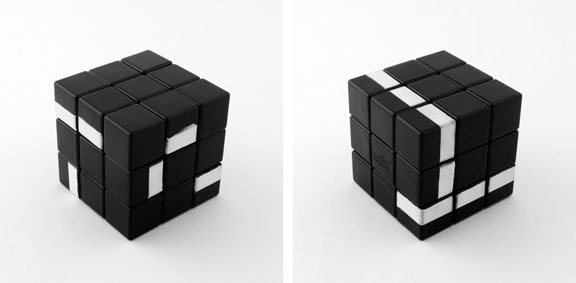
2009, 9 inkjet prints, 50 x 50 each and in version of 100 x 100 cm each.
Exhibition view from Seeing is believing, Galerie Hussenot, 2010, Paris.
Courtesy of the artist and ADN gallery, Barcelona.
Ed. of 5 + 2 A.P.
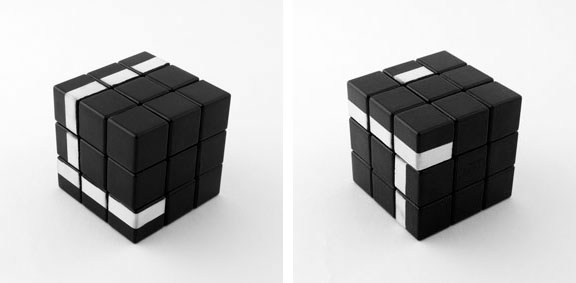
2009, 9 inkjet prints, 50 x 50 each and in version of 100 x 100 cm each.
Exhibition view from Seeing is believing, Galerie Hussenot, 2010, Paris.
Courtesy of the artist and ADN gallery, Barcelona.
Ed. of 5 + 2 A.P.
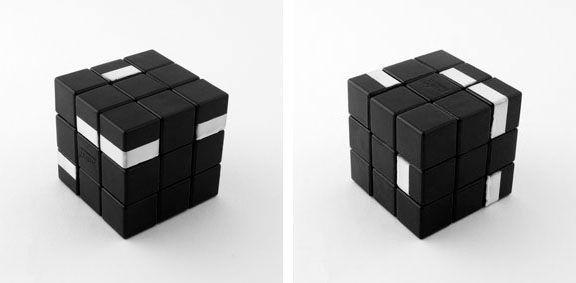
2009, 9 inkjet prints, 50 x 50 each and in version of 100 x 100 cm each.
Exhibition view from Seeing is believing, Galerie Hussenot, 2010, Paris.
Courtesy of the artist and ADN gallery, Barcelona.
Ed. of 5 + 2 A.P.
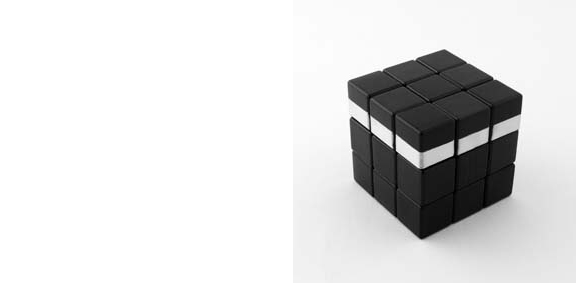
2009, 9 inkjet prints, 50 x 50 each and in version of 100 x 100 cm each.
Exhibition view from Seeing is believing, Galerie Hussenot, 2010, Paris.
Courtesy of the artist and ADN gallery, Barcelona.
Ed. of 5 + 2 A.P.
'' In Brainteaser for Moderate Muslims, the commonplace colourful cube is transformed, redirected towards new possibilities of its materialism.
The title suggests a playful reference to The Kaaba, a pre-Islamic monument rededicated by the prophet Muhammad,
while the work as a whole invites critical thinking, with tones of political reflection. ''
Elena Stanciu, PETRIe Magazine, 2016
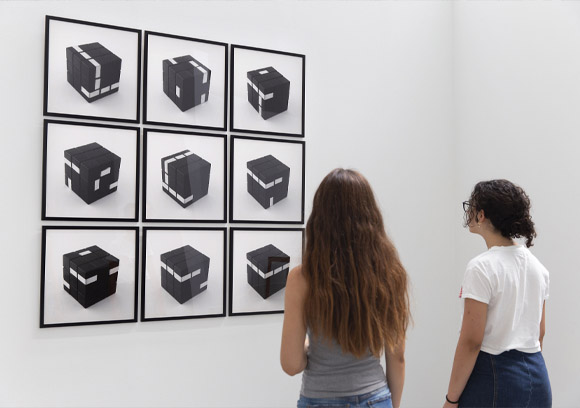
Brainteaser for moderate muslim
Exhibition view from The Day of the Awakening, CDAN, 2021, Huesca.
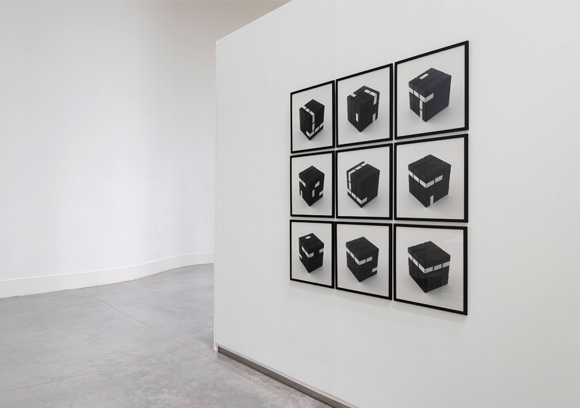
Brainteaser for moderate muslim
Exhibition view from The Day of the Awakening, CDAN, 2021, Huesca.
|
|
|
|
|
| Collection of a/political, London
|
Casse-tête pour un musulman modéré est une série de 9 photographies inspirées du célèbre jeu de logique Rubik's cube. L'œuvre s'inscrit dans un travail initié en 2004 avec la vidéo Manipulations et se poursuivant avec un projet photographique, une sculpture et finalement un jeu. Cube lui-même composé de cubes plus petits pouvant pivoter autour de trois axes tout en restant liés, le Rubik's Cube est au départ un dispositif mis au point par le professeur Erno Rubik dans le but d'étudier les propriétés logiques et mathématiques du cube. Chaque face est d'une couleur différente, et après mélange, les probabilités de retrouver l'ordre initial sont de 1 sur 43 252 003 274 489 856 000.
Après avoir réalisé la vidéo Manipulations en 2004, l’artiste s’est affronté à l’infinité des possibilités offertes par le Rubik’s cube. Il a alors élaboré la sculpture Casse-tête pour un musulman modéré qui est ensuite devenue l’objet qui a servi de modèle pour la série photographique du même nom. La forme présentée se compose de cubes à facettes noires, à l'exception d'une rangée de cubes portant un trait blanc sur une de ses faces. Les photographies mettent en scène des Rubik's cubes identiques à différents stades de leur résolution, jusqu'à l'étape finale, qui fait apparaître une bande blanche continue sur la rangée supérieure. Pour réaliser cette série, Mounir Fatmi n'a retenu que 9 configurations géométriques.
L'œuvre examine les rapports du croyant à un objet cultuel. Elle questionne le rapport de ce dernier aux dogmes et aux rituels de sa religion. Casse-tête pour un musulman modéré étudie le geste rituel accompli par le croyant lors du pèlerinage à la Mecque, à savoir la circumambulation autour de la Kaaba (littéralement le "cube"). Chaque photographie se propose comme la représentation du monument cultuel (la Kaaba), dont elle reprend la couleur noire et l'ornementation de la partie supérieure du cube par une frise calligraphique exprimant la profession de foi musulmane. Mounir Fatmi compare ainsi, d'une façon qui peut sembler humoristique, ironique, voire même paradoxale, la profession de foi irrationnelle du croyant effectuant des cercles autour du cube de la Mecque, aux stratégies rationnelles, logiques et mathématiques du joueur tentant de résoudre le Rubik's cube. L'objet de culte se voit transformé en jeu de décodage où la raison intervient à nouveau et invite alors à une approche scientifique du divin. Plutôt que de faire tourner aveuglément et à l'infini le cube, et de tenter en vain d'épuiser les combinaisons possibles afin de rétablir un ordre, le casse-tête invite peut être à développer une stratégie fondée sur l'usage de la raison.
Le titre de l'œuvre souligne la difficulté pour le croyant dit "modéré" - qui se réserve une distance critique par rapport aux dogmes de sa religion - à considérer de manière rationnelle l'objet de culte et le rituel qui lui est associé. La circumambulation autour de la Kaaba suppose un geste et une attitude irrationnelles du croyant. Elle suggère à celui-ci d'abandonner la réflexion et d'agir avec dévotion. L'œuvre exprime quant à elle la difficulté pour la raison, d'appréhender l'objet de culte et le rituel, difficulté envisagée à son tour comme un problème à résoudre. Avec Casse-tête pour un musulman modéré, Mounir Fatmi tente d'aborder un phénomène d'une grande complexité avec les moyens limités de l'art. Le recours aux techniques inspirées du minimalisme permet finalement une approche de la complexité avec un minimum de moyens : à l'aide d'une forme géométrique simple et limitée, il réalise la description d'un univers de probabilités approchant l'infini.
Série photographique limitée, l'œuvre fait naître chez ses spectateurs un sentiment d'impuissance lié à l'impossibilité d'épuiser toutes les possibilités du cube. Elle exprime également les limites et les possibilités de l'art et de la photographie, incapables de saisir l'objet dans son ensemble et dans toutes ses configurations, mais offrant des perspectives à partir desquelles la réflexion est possible. Chaque configuration du cube est une œuvre en soi. Le casse-tête renvoie alors éventuellement à l'infini des possibilités conceptuelles au sein duquel l’artiste peut opérer des choix et dresser la liste de ses propositions artistiques.
Studio Fatmi, Juillet 2017.
|
|
Brainteaser for a moderate Muslim is a series of 9 photographs inspired by the famous logic came Rubik’s Cube. The piece is part of a larger body of work initiated in 2004 with the video Manipulations and continued with a series of photographs, a sculpture and finally a game. A cube composed of smaller cubes which can rotate around three axes while remaining connected, Rubik’s Cube was originally a device created by professor Erno Rubik in order to study the logical and mathematical properties of cubes. Each face has a different color, and once they have been mixed up, the probability of finding the initial arrangement again is 1 to 43 252 003 274 489 856 000.
After having created the Manipulations video in 2004, the artist tackled the infinity of possibilities offered by the Rubik’s Cube. That’s when he developed the sculpture Brainteaser for a moderate Muslim that in turn became the object that served as a model for the identically titled series of photographs. The shape presented here is composed of cubes with black faces, with the exception of one row of cubes with a white line on one of their faces. The photographs show identical Rubik’s cubes in various stages of completion, until the final step, where a continuous white line appears on the upper row. To create this series, Mounir Fatmi selected only 9 geometrical configurations.
This piece looks at the relation of a believer to an object of worship. The work questions his or her relation to religious dogma and rituals. It studies the ritual gesture accomplished by the believer during the pilgrimage to Mecca, namely the circumambulation around the Kaaba (literally the “cube”). The logical game is conceived as a representation of the monument of worship (the Kaaba), emulating its black color and ornamentation on its superior section by a calligraphic frieze expressing the Muslim profession of faith. In this way, Mounir Fatmi compares, with what can be perceived as humor or even irony, the irrational profession of faith of a believer walking in circles around the cube in Mecca with the rational, logical and mathematic strategies of a player trying to solve a Rubik’s Cube. The object of worship is transformed into a deciphering game where reason is present again, encouraging a scientific approach to the divine. Rather than to blindly and endlessly rotate the cube in a vain attempt to try every possible combination to restore an order, perhaps the brainteaser invites the viewer to develop a strategy based on the use of reason.
The title of the work highlights the difficulty for a so-called “moderate” believer – who authorizes himself a certain critical distance with the dogma of his religion – to consider in a rational way the object of worship and the ritual associated with it. The circumambulation around the Kaaba requires an irrational gesture and attitude on the part of the believer. It pushes him to dismiss thought and to act with devotion. As for the work of art, it expresses the difficulty for reason to apprehend the object of worship and the ritual, a difficulty that is also seen as a problem that needs solving. With Brainteaser for moderate Muslim, Mounir Fatmi tries to tackle an extremely complex phenomenon with the limited means of art. Resorting to techniques inspired by minimalism enables him approach complexity with limited means: with a simple and limited geometric shape, he realizes the description of a universe of probabilities that touches on infinity.
A limited series of photographs, the work creates in the viewer a feeling of powerlessness due to the impossibility of going through all the possibilities of the cube. It also expresses the limits and possibilities of art and photography, incapable as they are of grasping the object in its entirety and in all its configurations, but offering perspectives from which reflection is possible. Each configuration of the cube is a work of art in itself. Perhaps the brainteaser refers to the infinity of conceptual possibilities among which the artist can make choices and the list of his artistic propositions.
Studio Fatmi, July 2017.
|
|
|
|